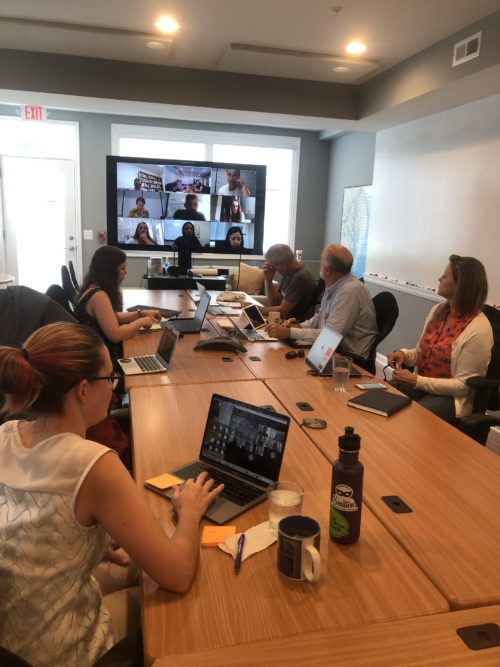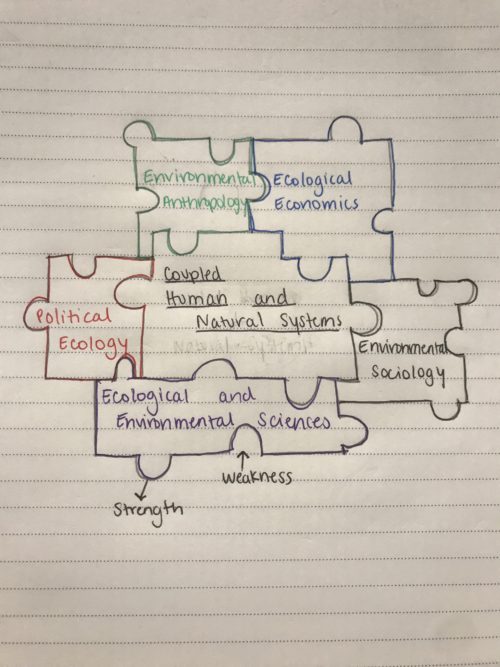Striving for synthesis: Overcoming environment and society obstacles
Matthew Wilfong · | Applying Science | 10 commentsBy: Matthew Wilfong
"We are drowning in information, while starving for wisdom. The world henceforth will be run by synthesizers, people able to put together the right information at the right time, think critically about it, and make important choices wisely."1
This quote was written on the whiteboard in the UMCES Annapolis office and could not have been more applicable to our class presentations and discussions this week. So far this semester, to some extent, we have been "drowning in information" attempting to understand five distinct social and natural science disciplines: ecological science, environmental anthropology, political ecology, environmental sociology, and ecological economics. This week was an assessment of our comprehension of these concepts, as we were asked to critique each of the five approaches and, most importantly, suggest which of the approaches would be most applicable to our own personal research. Each student was asked to prepare a presentation explaining how their chosen specific disciplines would apply to their research. This exercise required everyone to "synthesize" their own ideas, "put together the right information", "think critically about it", with the goal that they would be able to use these approaches in the future to inform and "make important choices wisely."

The student presentations this week ranged across a whole suite of environment and society issues, including wetland restoration, nitrogen and phosphorus management, cultural history of salt marshes, and urban stormwater management. All of these issues are incredibly complex, both scientifically and socially, so by providing a synthesized "road-map" to research and fully understand these systems, students could better assess their respective coupled human and natural system. The presentations were extremely thought-provoking. Seeing other perspectives allowed us to better grasp the sheer complexity of the issues and the unquestionable need for transdisciplinary approaches to solving these issues.
Oyster aquaculture was one of these environmental issues that a few students' research focused on. Oysters in the Chesapeake Bay region are extremely important ecologically, economically, and historically so any issues surrounding oysters are highly publicized and debated. The shift towards oyster aquaculture occurred after an Environmental Impact Statement (EIS) found that introducing Crassostrea ariakensis was not advisable2. This decision was highly political, with implications on the economics of the oyster fishery, ecological health of the Chesapeake Bay, and sociological shift for watermen towards aquaculture. The student presentations suggested that a shift towards aquaculture would mimic Ecological Modernization3 and provide a more resilient, sustainable future for the oyster fishery, both economically and ecologically. The implementation of oyster aquaculture requires a profound understanding of all five disciplines and their interactions between each other, highlighting the need for a multi-disciplinary approach in order to "make important decisions wisely" and account for all variables.

After all the students presentations, a class discussion about the critiques of the five approaches began by asking an important, grounding question "Are all five approaches relevant to your own research?" This question really drove home that virtually all environmental issues have roots within all five disciplines and only by assessing the problem holistically will sustainable solutions be found. The follow-up question was "If all approaches are relevant, how did you choose ones to apply to your research?" Again, this question demonstrated that the solutions to these environmental issues needs to be multi-disciplinary with all stakeholders accounted for. No single researcher can assess all these factors. The systems are just too complex. We can preface our research by incorporating these other approaches, but to adequately assess each problem, collaboration between disciplines and stakeholders is a necessity. Another intriguing question was asked, "How do you think your environmental issue will change over the next 50 years?" This question pins down the drastically different time-scales within environmental issues, where the effects of degradation are often far-removed and "invisible" to some extent. As a result, as highlighted in the most recent IPCC report, global climate change is occurring and can be remediated, but the issue is not only a scientific one, rather a political, social, and economic one. The future of environmental issues needs to extend past the scientific debate, and take a more post-normal science approach, because the "facts [are] uncertain, values in dispute, stakes high and decisions urgent".4
Finally, we were asked to draw some graphical illustration or depiction of our take-aways so far from the class. These illustrations were aimed to provide a framework for these conceptual ideas that can be somewhat abstract and complicated. One illustration featured puzzle pieces fitting together, each depicting one of the five disciplines, surrounding a puzzle piece representing coupled human and natural systems. This illustration grasped and conveyed the idea that these systems are "puzzles" that need all the pieces (approaches) to be fully understood and incorporated to see the full picture.
Environmental issues are incredibly complex and ingrained with human connections, but can be solved through collaborative, multi-disciplinary efforts. The synthesis presentations from each student and the class discussion emphasized the need for this type of approach; however, this work is much easier said than done. These issues need proactive solutions and integration of all approaches and we need to "start talking about the future we want, and less about the future we don't want".5

References
1. Wilson, E. O. (1999). Consilience: The unity of knowledge (Vol. 31). Vintage.
2. Maryland Department of Natural Resources. 2007. Environmental Impact Statement for Oyster Restoration in the Chesapeake Bay Including the Use of a Native and/or Nonnative Oyster.
3. Spaargaren, G., Mol, A., 1992. Sociology, Environment, and Modernity: Ecological Modernization as a Theory of Social Change. Soc. Nat. Resour. 5, 323-344.
4. Funtowicz, S. and Ravetz, J., 1993. Science for the post-normal age, Futures, 31(7): 735-755.
5. Ellis, E., 2018. Science Alone Won't Save the Earth. People Have To Do That. New York Times 1-4.
Next Post > MEES Colloquium 2018
Comments
-
Tan Zou 7 years ago
Very nice summary of last week’s class and thank you for providing more information about post-normal science. Last week’s class is a good review of what we have learned and it helps me better understand how to apply the knowledge to my own research. I also like the puzzle idea a lot, since it does not only show that all pieces should fit together but also how many pieces we are missing other than the five for a bigger and better picture.
-
Natalie 7 years ago
I really enjoyed this class and blog as it helped us natural resource scientists to get out of our box and see how we can build interdisciplinary teams that are essential for truly understanding the complex societal problems we face and their solutions. Hearing how other students have thought about integrating social sciences into their research was a highlight.
-
Alex Sahi 7 years ago
I agree that a multi disciplinary approach should be taken in the future regarding scientific work and environmental issues. Other disciplines are helpful in determining how to resolve said issues, but I am cautious to just use any approach without critically evaluating the it first. Some of theories we have learned about present the beginnings of the discipline, such as in environmental anthropology, and further developments have occurred that provide even more useful tools for thinking about environmental issues that we should consider.
-
Brendan Campbell 7 years ago
I appreciate the term 'drowning' for the material. While it is cumbersome to consider all these perspectives in one setting there are many applications where each piece of the puzzle is necessary. The Chesapeake Bay community is a perfect example of just that. Between agriculture and fisheries on the eastern shore to the cities upstream, there are a lot of diverse people to keep track of and gaining such an eclectic background will be advantageous in the future as we move forward in our research.
-
Alana Todd-Rodriguez 7 years ago
I agree with you that the presentations were very thought-provoking. It was interesting to see how everyone was able to weave together the approaches we have learned with their own research. I think it is important now more than ever that we put those multi-disciplinary efforts at the forefront of research agendas, as the complexity of issues cannot be addressed through one field alone. Great job summarizing the class!
-
Morgan Ross 7 years ago
This blog was a perfect summary of the class period. Was the quote written by Bill or someone in the class? The message in that quote truly breaks down the goal of those who study coupled human and natural systems.
I enjoyed the class period and thought it was beneficial to discuss the multiple perspectives at large. I liked being able to compare and contrast the use of the five perspectives after having examined each one individually. -
Brian Scott 7 years ago
The post-normal science diagram is perfect. It's why I left professional consulting and came back to school for a PhD. I wanted to operate in the world with high uncertainty and high stakes. Environmental consultancy, on the other hand, continues to try to devolve toward applied science. It's a good place to be - easier to have stable revenue. But...boring!!! I think the best thing scientists can do right now is to educate the public not about science, but about uncertainty, and what it means. Uncertainty and high risk can be frightening (the future we don't want), but it also where exhilaration comes from - imagining the future we want.
-
Emily Nastase 7 years ago
I loved listening to everyone's presentations last week. It was really interesting to me how most of us decided to describe a multi- or transdisciplinary approach to our research. Matthew's point above about assessing environmental issues holistically (through all five disciplines) is on point!
-
Shannon Hood 7 years ago
This was a very thought provoking and enjoyable class. After spending so much time on our own research, it's really interesting to see how other students view their research in terms of interactions with cultural/sociological systems. The holistic approach to studying human/natural systems is very applicable and I'm so glad that Morgan's creative puzzle diagram made its way into this blog!
-
Srishti Vishwakarma 7 years ago
I really liked this line from your blog, "virtually all environmental issues have roots within all five disciplines and only by assessing the problem holistically will sustainable solutions be found." It is true and this mid-term has exposed us to these disciplines and their interconnection.
Also, climate change also has a role to play but may be that climate change is caused by people.
Hence, last week's class was a great avenue to dive deeper into the five disciplines. Your blog perfectly illustrates all of the pieces of class and all previous theories.